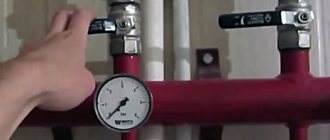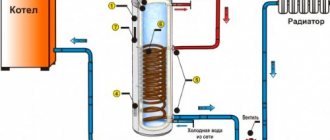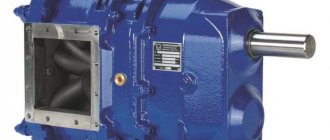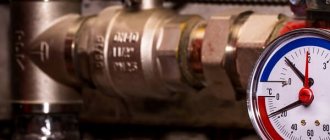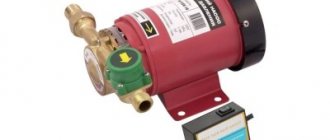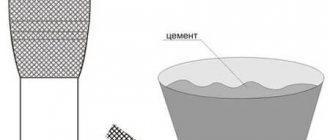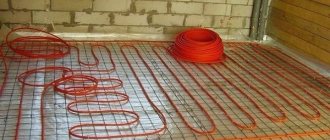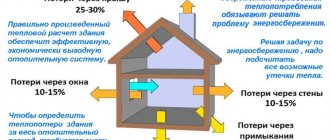Peculiarities
The benefits of such a device only seem unrealistic. Manufacturers promise that by spending 1 kW of electricity, we will get up to 5 kW of heat in the house.
There is no perpetual motion machine with an efficiency of 300-500%.
A heat pump does not produce heat like a coal or gas furnace. He pumps it from the space surrounding the house. For example, it collects from the bottom of a reservoir. This, by the way, is the most profitable source of heat.
At a depth of several meters, the water temperature changes little.
Temperature stability is maintained by the release of heat in the planet's molten core. There is a natural nuclear reactor inside the Earth.
This heat is not enough to warm the entire surface in winter.
But you can collect energy from the surface or from deep wells, concentrate it, and direct it to heat the cottage.
Device
The principle of operation has long been known. There are three closed, sealed circuits - internal, compressor, external.
Main components:
- Heating system. It is optimal to use warm floors. An additional option is hot water supply.
- Capacitor. Transfers energy collected externally from the refrigerant (usually freon) to the heating fluid (water).
- Evaporator. Collects thermal energy from the coolant (for example, ethylene glycol) circulating in the external circuit.
- Compressor. Pumps refrigerant from the evaporator, converting it from gaseous to liquid, increasing pressure and cooling it in the condenser.
- Expansion valve. Installed by evaporator. Regulates the flow of refrigerant.
- External contour. Placed on the bottom of a reservoir or lowered into wells.
- Internal and external circuit pumps.
- Automation. Controls the system according to a given amount of room heating and changes in outside air temperature.
In the evaporator, the coolant of the external circuit is cooled, giving off heat to the refrigerant, and then pumped through the external circuit by a pump. There it heats up and the cycle repeats again.
The external contour in the pond near the building looks like this.
The collector is effective all year round. In winter, at a depth of more than 3 meters, the water temperature is sufficient for heating.
After the evaporator, the refrigerant passes through the compressor, where its pressure and temperature increase. Then the condenser transfers heat to the heating system.
The refrigerant then passes through the choke, where the pressure drops sharply due to expansion. When it transforms into a gaseous state, the temperature of the refrigerant decreases greatly almost instantly. This process can be experienced in practice when refilling a gas lighter from a can of liquefied gas. A significant temperature difference contributes to the effective absorption of heat by the refrigerant from the external circuit.
There is an option with an open collector. Possible when the water is of good quality. Then the system and the pump are not threatened by siltation, deposition of hardness salts, or accelerated corrosion.
Such heat generators found practical use only after the energy crises of the 70s of the last century.
Until then, their development was hampered by the relative cheapness of energy resources - oil, gas, etc. In addition, the imperfection of technology hampered the mass introduction of innovation.
Principle of operation
A heat pump (HP) works like a refrigerator, but exactly the opposite - the physical processes are mirrored. They are very similar - the service life is long - usually more than 30 years.
When the refrigerant enters the evaporator, this phase is called isothermal expansion. Freon receives heat from the external collector, the pressure drops.
Then adiabatic compression occurs - the compressor increases the pressure of the refrigerant. At the same time, its temperature increases to a maximum of +70° C.
Passing the condenser, freon becomes a liquid, because at increased pressure it gives off heat to the heating circuit. This phase is called isothermal compression.
When the freon passes through the choke, the pressure and temperature drop sharply. Adiabatic expansion occurs.
At first glance it is difficult to understand. But this is a hundred times simpler than what happens inside a regular smartphone. This does not prevent us from using the capabilities of the gadget. The same thing happens when operating a HP.
When all systems are installed, tested, and adjusted, the user will only switch a few toggle switches and buttons.
For example, to set different heating temperatures for a children's room, living room, kitchen.
Advantages
The development of transport, the Internet, mobile communications, and construction technologies tie people less and less to one place. More and more people are choosing to live outside the city “in the lap of nature.” There you can already get the usual “city” comfort, remote earnings, and communication via the Internet with all continents. Therefore, and also due to the constant increase in the cost of energy resources, HP is becoming more and more in demand.
It also has other benefits:
- Environmentally friendly.
- Uses a renewable energy source.
- There are no regular costs of consumables after start-up.
- Automatically adjusts heating based on outside air temperature.
- The payback period for initial costs is 5-8 years.
- Provides hot water supply.
- In summer it works like an air conditioner, cooling the supply air.
- Minimum energy consumption - generates from 4 to 6 kW of heat with 1 kW of electricity consumed.
- With an electric generator of any type, the heating and air conditioning of a cottage “remote from civilization” will be independent.
- Adaptation to the “smart home” system for remote control and additional energy savings is possible.
- The rise in prices for energy resources (oil, gas) has almost no effect on the personal budget. If you install a wind or solar generator, you will get complete independence. A hydroelectric generator is an ideal option.
Flaws
Like any device, this system has a number of disadvantages.
External contour
Due to the constant extraction of geothermal energy near the location of the external collector pipes, the soil cools. In the north, the short summer does not allow for complete restoration of energy potential. This gradually reduces the effectiveness of the HP over approximately 5 years. Then thermal equilibrium stabilizes.
Cooling of the soil can be avoided if you use water-to-water HP by placing the external collector in a reservoir at a depth of more than 3 meters.
Another option is to place wells around the house. Then heat is collected from a huge area of the entire aquifer, crossed by drilled holes.
Wells are an expensive undertaking. Especially in dense soil. Not to mention the rocks. Here you can use the option with an open external collector.
You can get by with two wells. One is for groundwater intake. The second is for draining back into the aquifer. This option is possible if the water quality is good.
Filters cannot always help if there are too many hardness salts or suspended microparticles. Before installation, it is necessary to do an analysis of the water from the well.
Compressor circuit
Electric motors are noisy during operation. The compressor is even larger and also creates vibration. The same thing happens during operation of a home refrigerator. At the same time, the power of the HP is much greater. Noise and vibration too.
Unpleasant effects are easy to avoid:
- The heat pump is enclosed in a sound-insulating casing.
- The compressor is attached to the support frame through rubber gaskets with springs.
- It is better to place all equipment in a utility room or basement. Forced ventilation must be provided. Freon leakage can be hazardous to human health.
Inner circuit
The heating system is filled with water heated to +35° C. This is not enough for conventional radiators. Especially for the northern regions.
But TN works well with heated floors. When designing, it is necessary to provide for a sufficient degree of thermal inertia of the external fences of the building - the thickness and material of the walls, floors, roof, triple glazing.
Warm floors and heated supply air create comfortable and healthy conditions for human life inside the building.
In addition to air temperature, radiation temperature is of great importance - infrared radiation from walls, floors, and ceilings. For example, when a person sits by the fire at night, all the hot air goes up, without warming anyone. In this case, the side of the person facing the fire is warm, but the back is cold.
Price
The start-up costs are high. The cost of equipment supply, installation, and commissioning significantly exceeds traditional heating systems. But the house is built to last for decades.
Therefore, it would be correct to take into account the operating costs for the entire service life of the HP - 30 years. Even if current tariffs and energy prices remain the same, the cost-effectiveness of a water-to-water system is beyond competition.
Annual savings compared to:
- gas boiler - 70%;
- electric heating - 350%;
- solid fuel boiler - 50%.
Now you need to multiply existing or projected costs by 30 years. The savings will cover the initial investment many times over.
Power outage
Compressors, pumps, automation require uninterrupted power supply. In case of a shutdown, there must be an electric generator with automatic start. Its power must cover the sum of the starting currents.
There is a big plus - after a second of full load, at the moment the HP starts, more than 40% of the generator’s power is released. This is enough to power the rest of your home appliances and lighting.
Operating principle of heat pumps
Any HP contains a working medium called refrigerant. Usually freon acts in this capacity, less often ammonia. The device itself consists of only three components:
- evaporator;
- compressor;
- capacitor.
The evaporator and condenser are two reservoirs that look like long curved tubes - coils. The condenser is connected at one end to the outlet pipe of the compressor, and the evaporator is connected to the inlet pipe. The ends of the coils are joined and a pressure reducing valve is installed at the junction between them. The evaporator is in contact – directly or indirectly – with the source medium, and the condenser is in contact with the heating or hot water system.
Working principle of a heat pump
The operation of HP is based on the interdependence of gas volume, pressure and temperature. Here's what happens inside the unit:
- Ammonia, freon or other refrigerant, moving through the evaporator, is heated from the source medium, say, to a temperature of +5 degrees.
- After passing through the evaporator, the gas reaches the compressor, which pumps it into the condenser.
- The refrigerant pumped by the compressor is held in the condenser by a pressure reducing valve, so its pressure here is higher than in the evaporator. As is known, with increasing pressure the temperature of any gas increases. This is exactly what happens to the refrigerant - it heats up to 60 - 70 degrees. Since the condenser is washed by the coolant circulating in the heating system, the latter also heats up.
- Through the pressure reducing valve, the refrigerant is discharged in small portions into the evaporator, where its pressure drops again. The gas expands and cools, and since part of the internal energy was lost by it as a result of heat exchange at the previous stage, its temperature drops below the original +5 degrees. Following the evaporator, it is heated again, then pumped into the condenser by the compressor - and so on in a circle. Scientifically, this process is called the Carnot cycle.
The main feature of HP is that thermal energy is taken from the environment literally for nothing. True, to produce it, you need to spend a certain amount of electricity (for the compressor and circulation pump/fan). But HP still remains very profitable: for every kWh of electricity spent, you can get from 3 to 5 kWh of heat.
Efficiency
Over time, the profitability of HP becomes more and more obvious due to the constant increase in the cost of energy resources. Technology also does not stand still.
Programmable control circuits for home appliances with remote access no longer surprise anyone. The heat pump is seamlessly integrated into the smart home system, which reduces equipment wear and extends its service life.
A properly selected and high-quality installed heat pump is a guarantee of providing heat regardless of the time of year and market fluctuations in energy prices.
But a heat pump can achieve maximum efficiency if you decide on the choice of heating system at the early stages of building design. Then it is possible to choose the optimal materials and thickness of enclosing structures with the required thermal conductivity and thermal inertia.
Prices and manufacturers
The approximate average market cost of equipment and its installation is:
Horizontal collector:
- Pump – $4500;
- installation – $2500;
- operating cost – $350 per year.
Geothermal probe:
- Pump – $4500;
- installation – $4500;
- operating cost – $320 per year.
Air - for home:
- Pump – $6500;
- installation – $400;
- operating cost – $480 per year.
Water-to-water pump for home:
- Heat pump – $4500;
- installation – $3500;
- operating cost – $280 per year.
The prices shown are not final. The final cost will depend on the country and manufacturer of the device, type of terrain, climatic features, drilling costs, construction conditions, etc. For example, the price of an air pump from a Russian manufacturer will be about $7,000, and from a foreign one – $13,000.
Also, do not forget about the cost of electricity. Despite the fact that the equipment does not consume a lot of electricity, these costs should certainly be taken into account when drawing up an overall estimate and planning a budget.
Criterias of choice
At first glance, the need for labor-intensive laying of several hundred meters of plastic pipes on the bottom of a reservoir or even more costly drilling of wells for water-to-water HP seems doubtful. After all, there are air-to-air systems. There is no external collector at all. For example, a very high-quality Japanese air-to-water inverter HP produced by Mitsubishi Heavy.
It's simple - the density of water is 800 times greater than air. And warmth too. Therefore, the efficiency and economy of water systems will always be greater than that of Mitsubishi.
Power calculation
For preliminary calculations, a simplified formula is usually used: 700 watts of heat are required per 10 m2 of heated building. Then for a house with an area of 250 m2 you need to buy a water-to-water heat pump with a power of 175 kW.
To ensure hot water supply, the final figure must be increased by 15%.
This does not take into account the large difference between climatic zones, for example, Crimea and the Moscow region. The heat loss of the external enclosing structures of different buildings also differs greatly. There are other factors that must be taken into account in the calculation. Only specialists can do this.
Calculation of a horizontal heat pump collector
The efficiency of a horizontal collector depends on the temperature of the medium in which it is immersed, its thermal conductivity, and the area of contact with the surface of the pipe. The calculation method is quite complex, so in most cases averaged data is used.
It is believed that each meter of heat exchanger provides the HP with the following thermal power:
- 10 W – when buried in dry sandy or rocky soil;
- 20 W – in dry clay soil;
- 25 W – in wet clay soil;
- 35 W – in very damp clay soil.
Thus, to calculate the length of the collector (L), the required thermal power (Q) should be divided by the calorific value of the soil (p):
L = Q/p.
The values given can only be considered valid if the following conditions are met:
- The area of land above the sewer is not developed, shaded or planted with trees or bushes.
- The distance between adjacent turns of the spiral or sections of the “snake” is at least 0.7 m.
When calculating the collector, it should be taken into account that the soil temperature after the first year of operation drops by several degrees.
Review of manufacturers
Installation costs, taking into account the cost of wells, can range from 5 to 10 thousand dollars. When using an open reservoir it will be 1.5-2 times cheaper.
Manufacturers of heat pumps are divided into three price categories:
- Cheap Chinese ones. For example, Meeting (China), maximum power - 7 kW, heated area - 50-100 m2, price - 95,200 rubles.
- They are produced under the American brand in China. For example, Mammoth (USA/China), maximum power - 7.8 kW, heated area - 50 m2, price - 261,000 rubles.
- The most expensive ones are traditionally German. For example, Stiebel Eltron (Germany), maximum power - 9.9 kW, heated area - 50 m2, price - 645,000 rubles.
It is recommended to choose an operator that provides a full range of services:
- design;
- supply;
- installation;
- commissioning works;
- service maintenance.
Prices for different heat pump models
Heat pump
What is cheaper for heating: electricity, gas or heat pump?
We present the costs of connecting each type of heating. To present the general picture, let’s take the Moscow region. Prices may differ in regions, but the price ratio will remain the same. In the calculations we assume that the site is “bare” - without gas or electricity.
Connection costs
Heat pump. Laying a horizontal contour at MO prices - 10,000 rubles per shift of an excavator with a bucket bucket (removes up to 1,000 m³ of soil in 8 hours). A system for a house of 100 m² will be buried in 2 days (true for loam, on which you can remove up to 30 W of thermal energy from 1 square meter of circuit). About 5,000 rubles will be required to prepare the circuit for operation. As a result, the horizontal option for placing the primary circuit will cost 25,000.
The well will be more expensive (1,000 rubles per linear meter, taking into account the installation of probes, piping them into one line, filling with coolant and pressure testing), but it will be much more profitable for future operation. With a smaller occupied area of the site, the output increases (for a 50 m well - at least 50 W per meter). The pump's needs are covered and additional potential appears. Therefore, the entire system will not work for wear, but with some reserve power. Place 350 meters of contour in vertical wells – 350,000 rubles.
A gas boiler. In the Moscow region, for connection to the gas network, work on the site and installation of the boiler, Mosoblgaz requests from 260,000 rubles.
Electric boiler. Connecting a three-phase network will cost 10,000 rubles: 550 for local electrical networks, the rest for the distribution board, meter and other contents.
Consumption
To operate a HP with a thermal power of 9 kW, 2.7 kW/h of electricity is required - 9 rubles. 53 kopecks at one o'clock,
The specific heat during combustion of 1 m³ of gas is the same 9 kW. Household gas for Moscow region is priced at 5 rubles. 14 kopecks per cubic meter
An electric boiler consumes 9 kW/h = 31 rubles. 77 kop. at one o'clock. The difference with TN is almost 3.5 times.
Exploitation
- If gas is supplied, then the most cost-effective option for heating is a gas boiler. The equipment (9 kW) costs at least 26,000 rubles, the monthly payment for gas (12 hours per day) will be 1,850 rubles.
- Powerful electrical equipment is more profitable from the point of view of organizing a three-phase network and purchasing the equipment itself (boilers - from 10,000 rubles). A warm house will cost 11,437 rubles per month.
- Taking into account the initial investment in alternative heating (equipment 275,000 and installation of a horizontal circuit 25,000), a heat pump that consumes electricity at 3,430 rubles/month will pay for itself no earlier than in 3 years.
Comparing all heating options, provided that the system is created from scratch, it becomes obvious: gas will not be much more profitable than a geothermal heat pump, and heating with electricity in the next 3 years is hopelessly inferior to both of these options.
Detailed calculations in favor of operating a heat pump can be found by watching a video from the manufacturer:
Some additions and experience of effective operation are highlighted in this video:
Nuances of installation and operation
Before assembling and launching the system, it will be useful to study the advice of those who have already installed the device in practice and began to use it for its intended purpose.
Where to get heat
At the initial stage of designing heating using water-to-water heat pumps, it is necessary to select a primary heat source.
The best option is an open body of water (pond, river, lake, sea) of sufficient area and depth at a distance of up to 100 meters from the house.
If this is not possible, then wells are drilled to the depth of the aquifer.
There are two options here:
- For an open type external collector, you will only need two wells at a distance of 20 meters from each other. From one, water is pumped to heat the evaporator of the condenser circuit. Then it is reset to the second one. In this case, the well flow rate must be sufficient. This is determined by pumping out water with a submersible pump. Before continuing design work, it is necessary to carry out a laboratory analysis of the water for the content of hardness salts and suspended particles.
- If a negative analysis or debit result is obtained, more drilling will be required. It will be necessary to place approximately the same length of pipes in the wells as in an open reservoir.
Operation and Maintenance
After completion of commissioning work, the owner controls only two buttons: on/off and winter/summer mode (heating or cooling), and also regulates the temperature in different rooms.
Annual inspection and maintenance are carried out by service specialists - control:
- no freon leaks;
- lubricants;
- coolants in external and internal circuits;
- automation operation.
Heat pump operation when operating according to the “ground-water” scheme
The collector can be installed in the ground in three ways.
Horizontal option
The pipes are laid in trenches in a “snake” pattern to a depth exceeding the freezing depth of the soil (on average, from 1 to 1.5 m).
Such a collector will require a fairly large plot of land, but any homeowner can build it - no skills other than the ability to work with a shovel will be required.
It should, however, be taken into account that constructing a heat exchanger manually is a rather labor-intensive process.
Vertical option
Collector pipes in the form of loops shaped like the letter “U” are immersed in wells with a depth of 20 to 100 m. If necessary, several such wells can be built. After installing the pipes, the wells are filled with cement mortar.
The advantage of a vertical collector is that its construction requires a very small area. However, there is no way to drill wells more than 20 m deep on your own - you will have to hire a team of drillers.
Combined option
This collector can be considered a type of horizontal, but its construction will require much less space.
A round well with a depth of 2 m is dug on the site.
The heat exchanger pipes are laid in a spiral, so that the circuit looks like a vertically installed spring.
Upon completion of installation work, the well is backfilled. As in the case of a horizontal heat exchanger, all the necessary work can be done with your own hands.
The collector is filled with antifreeze - antifreeze or ethylene glycol solution. To ensure its circulation, a special pump is inserted into the circuit. Having absorbed the heat of the soil, the antifreeze enters the evaporator, where heat exchange occurs between it and the refrigerant.
It should be taken into account that unlimited heat extraction from the ground, especially when the collector is located vertically, can lead to undesirable consequences for the geology and ecology of the site. Therefore, in the summer, it is highly desirable to operate HPs of the “soil-water” type in reverse mode - air conditioning.
A gas heating system has a lot of advantages and one of the main ones is the low cost of gas. The heating diagram for a private house with a gas boiler will tell you how to arrange heating of your home with gas. Let's consider the heating system design and replacement requirements.
Read about the features of choosing solar panels for heating your home in this topic.
How to make a water-water pump with your own hands
Making a water-to-water heat pump with your own hands is many times more complicated than a household refrigerator. The working sample presented below is assembled according to the “pipe-in-pipe” scheme. Productivity - 4 kW of heat per 1 kW of consumed electricity.
Compressor
A ZR-24 scroll compressor is used here. Mounted inside heat exchanger bays, which are stacked on top of each other.
A pressure gauge is installed after the compressor.
Capacitor
You will need 1/2" diameter copper tubing with terminations to connect to the compressor circuit.
The length of the heat exchange coil can be calculated using the formula:
L=W/0.8(t1—t2)3.14d
W is the power of the heat pump, equal to four times the electrical power of the compressor.
t1 is the water temperature after heating by the condenser. It is assumed to be +35° C.
t2 is the inlet water temperature. For the heated floor option - +30° C.
d is the diameter of the copper tube.
The copper pipe must be rolled into a coil with a diameter of 1 meter inside a HDPE (low-density polyethylene) pipe with a diameter of 25 mm.
Evaporator
Calculation of the heat transfer surface of a copper tube is based on the same formula. A copper pipe with a diameter of 3/4 inch is inserted into a HDPE pipe with a diameter of 32 mm and they are rolled together into a coil with a diameter of 1 meter.
Welding and filling with freon
When all the circuits are assembled together with the thermostat, you need to invite a refrigerator specialist to fill the compressor circuit with freon.
In addition, you will need at least 2 regulators: for the temperature of the indoor air and the degree of heating of the “warm floor” system.
Example of heat pump calculation
We will select a heating element for the heating system of a one-story house with a total area of 70 square meters. m with a standard ceiling height (2.5 m), rational architecture and thermal insulation of enclosing structures that meet the requirements of modern building codes. For heating the 1st sq. m of such an object, according to generally accepted standards, it is necessary to spend 100 W of heat. Thus, to heat the entire house you will need:
Q = 70 x 100 = 7000 W = 7 kW of thermal energy.
We choose a heat pump of the TeploDarom brand (model L-024-WLC) with a thermal power W = 7.7 kW. The compressor of the unit consumes N = 2.5 kW of electricity.
Reservoir calculation
The soil in the area allocated for the construction of the collector is clayey, the groundwater level is high (we assume the calorific value p = 35 W/m).
The collector power is determined by the formula:
Qk = W – N = 7.7 – 2.5 = 5.2 kW.
Determine the length of the collector pipe:
L = 5200 / 35 = 148.5 m (approx.).
Based on the fact that laying a circuit longer than 100 m is irrational due to excessively high hydraulic resistance, we accept the following: the heat pump collector will consist of two circuits - 100 m and 50 m long.
The area of the site that will need to be allocated for the collector will be determined using the formula:
S = L x A,
Where A is the step between adjacent sections of the contour. We accept: A = 0.8 m.
Then S = 150 x 0.8 = 120 sq. m.
Useful tips
At all stages of building a house, starting from the design stage, we must remember that the HP is an inertial system. It can be compared to a massive Russian stove, which was usually heated once a day during cooking. Then the accumulated heat warmed the home until the next morning.
Walls made of heavy logs have a fairly high degree of thermal inertia. Simply put, they cool down slowly when it gets colder at night. Good thermal inertia for thick stone walls, as well as for heavy concrete or brick.
Polystyrene foam and foam concrete have good thermal insulation properties. But due to their low specific gravity they have low thermal inertia. A heater in a building with walls made of such materials, when the outside air temperature sharply drops, will not always be able to “pump” enough heat from outside into the “warm floor” heating system.
Other factors must also be taken into account:
- To reduce heat loss or avoid freezing of pipes in the main between the house and the wells or collector, it is necessary to lay them to a depth below the freezing level. In Crimea - 0.75 meters is enough, and at the latitude of Moscow - at least 1.5.
- The greatest heat loss is usually through windows. Therefore, triple glazing is not a luxury at all, but an economically sound construction solution. The ideal option is to use glass that can reflect infrared rays.
- In the case of using the option of 2 wells for collecting and draining water, the distance between them must be at least 20 meters.
- It is better to try a homemade TN first in a utility room or garage. Installing heated floors in a residential area will require additional costs. Find out the order of the corner fireplace by following the link.
Which pump to choose
To decide which device to choose, you should consider factors:
- estimated budget - how much money the owner is willing to spend on arranging and connecting the complete system;
- what is the existing or planned heating system inside the house - warm floor, radiator, etc.;
- how many sq.m. is the owner willing to allocate on the site for the creation of a collector;
- Is it possible to drill deep?
- the need for geological expertise (if it is planned to install a geothermal probe) in order to understand how deep the collector should be placed;
- Is it necessary to condition the air flow in summer;
- Will air heating devices be installed?
During the selection process, it is recommended to pay attention to the “heat transformation coefficient” parameter (denoted as ϕ). It determines how effective the device will be. If upon purchase it is indicated that ϕ = 4, then with an electricity consumption of 1 kW, the heat pump will produce 4 kW of heat energy.
When planning your budget, it is important to take into account not only the cost of purchasing a pump, but also future financial costs of operation. Often these parameters differ.
For example, when installing an air-water system, installation costs will be low, but large operating investments will be required due to low efficiency. If you need to minimize operating costs, then you should choose a vertical ground source heat pump.
The cost of a ground or water device and its connection is quite high; a large initial investment will be required. However, after 5-10 years, a heat pump used for heating will pay for itself. Therefore, a decision on the need to purchase this device should be made on the basis of financial capabilities and conditions of construction of the building (type of terrain, climate, etc.).
If, for example, deep drilling on a site is impossible, its area does not allow the placement of a horizontal collector, and there are no bodies of water nearby, the only solution is to install an air source heat pump for heating the house.
